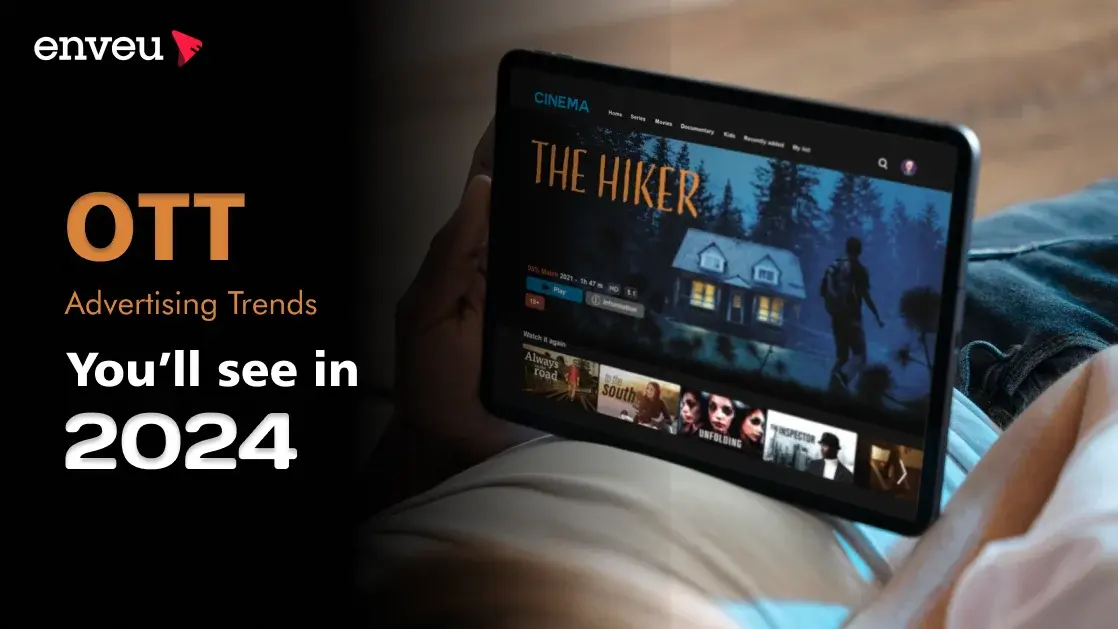2024 OTT Advertising Trends: A Must-Watch for Marketers
Dive into the ever-evolving world of OTT advertising trends! Discover the hottest trends shaping 2024, from interactive formats to data-driven targeting.

Television is not dying; it is evolving consumer habits.
With the rise in popularity of streaming services, traditional television is becoming a thing of the past, and so are the commercials we grew up with. Marketing experts have had to come up with innovative strategies to break into streaming and OTT (over-the-top) advertising, bypassing commercials altogether.
OTT advertising is enabling marketers to connect with target and potential audiences through their streaming services like Netflix, Hulu, Disney, and more. Through this, marketers can reach the mass audiences that have become unreachable through traditional television commercials. In this blog, we will discuss the best practices for OTT advertising trends for 2024, which will help you get your business in front of your target audience.
Let’s get studying!
Table of Contents
ToggleWhy is OTT advertising trending?
OTT advertising is a cost-effective and innovative way to deliver ads directly to viewers through streaming devices and services. Viewers can see those ads via their digital devices, like a connected TV (CTV), laptop, tablet, or smart TV. There are many reasons why OTT advertising is trending right now.
- Reaching A Targeted Niche Audience
- Increasing Engagement
- Minimizing Ad Spend Waste

5 Developing OTT Advertisement trends for 2024
1. AVOD and FAST channels are earning huge streaming viewership
AVOD and FAST services offer viewers the flexibility to enjoy entertainment on their terms; hence, most smart TV come pre-loaded with them. As a result, these are the most popular OTT models based on user behavior today:
- AVOD—ad-supported video on demand—provides free content to consumers in exchange for viewing advertisements. The generated ad revenue is utilized for production and content distribution.
- FAST — Free ad-supported TV streaming offers a live TV experience without requiring a subscription. Marketers can seamlessly insert ads into the conventional ad break during streaming.
- SVOD—Subscription video on demand allows viewers to access content by subscribing. As the predominant OTT service model, the competition to retain subscriptions has led to the emergence of additional AVOD and FAST options.
Currently, there are few ad-supported streaming services available, including Peacock and Tubi. Both are starting to catch up to subscription-based competitors for total viewership.
2. More ott subscription bundles
A recent Parks Associates study found that 59% of OTT subscribers prefer bundled services that combine OTT with other domestic subscriptions. Integrating OTT with existing subscriptions offers simplicity, value, and convenience. Dedicated OTT bundles also allow customers to access a variety of content in one package, providing an affordable and efficient way to enjoy multiple streaming services.
3. Personalized advertising
Irrelevant ads waste money and influence purchasing decisions negatively. Personalizing ads based on consumer characteristics, group dynamics, and optimal timing fosters a stronger connection. Today’s digital audiences expect and appreciate personalized experiences, like Spotify’s playlists and Netflix’s tailored interfaces.
4. Advance attribute tracking
OTT attribution tracks ad campaign performance on streaming services, often tied to CTV, which dominates the big-screen experience at home. CTV’s prevalence enhances OTT attribution, offering valuable metrics akin to traditional TV targeting. By aligning consumer behavior with streaming habits and refining targeting strategies, coupled with backend attribution, advertisers gain insights into how ad performance impacts campaign results.
5. OTT for localized targeting & measurement
Local business advertising is more effective with OTT. It tracks real-time data, surpassing traditional TV methods. Hyper-local targeting tailors promotions to specific areas, maximizing impact. Marketers can strategize seasonal ads or compete with local brands. OTT platforms customize content and use parameters like zip codes for precise local targeting.
OTT Ads by Platforms

Final Thought
OTT advertising is one of the most cost-effective marketing channels that helps brands reach cord-shavers, cord-cutters, and cord-nevers. By increasing the demand and popularity of streaming content, most advertisers want to target audiences in a much more affordable, streamlined, and measurable way.
Frequently Asked Questions (FAQ)
Ans: OTT advertising, or Over-The-Top advertising, refers to the delivery of video content via the internet, bypassing traditional cable or satellite TV services. Unlike traditional advertising, which relies on scheduled programming, OTT allows users to access content on-demand through various streaming services. This method of advertising targets viewers on internet-connected devices, offering a more personalized and flexible approach compared to traditional channels.
Ans: Data plays a crucial role in OTT advertising strategies by enabling advertisers to target specific audiences more accurately. Advertisers leverage user data to understand consumer behavior, preferences, and demographics, allowing for personalized ad delivery. This data-driven approach enhances the effectiveness of campaigns, ensuring that ads reach the right audience at the right time, ultimately maximizing engagement and conversion rates.
Ans: While OTT advertising presents numerous opportunities, it also comes with challenges. Ad fatigue is one concern, as viewers may become overwhelmed with the volume of ads, leading to decreased effectiveness. Measurement and attribution can be challenging in the OTT environment, making it difficult for advertisers to track the success of their campaigns accurately. Additionally, the fragmentation of the OTT market poses a challenge, requiring advertisers to navigate various platforms to reach their target audience effectively.
Ans: The increasing popularity of ad-supported streaming services has prompted advertisers to adjust their strategies. Advertisers are exploring innovative formats, such as shorter and more engaging ads, to capture viewers’ attention in a limited time frame. Collaborations with content creators and platforms are also on the rise, allowing brands to integrate seamlessly into the streaming experience and create authentic connections with the audience.
Ans: The future of OTT advertising looks promising, with continued growth expected. As technology evolves, we can anticipate advancements in targeting capabilities, ad formats, and measurement tools. The integration of artificial intelligence and machine learning is likely to play a more significant role, optimizing ad delivery and personalization. Overall, the industry is poised for continuous innovation, providing advertisers with new opportunities to connect with audiences in meaningful way.